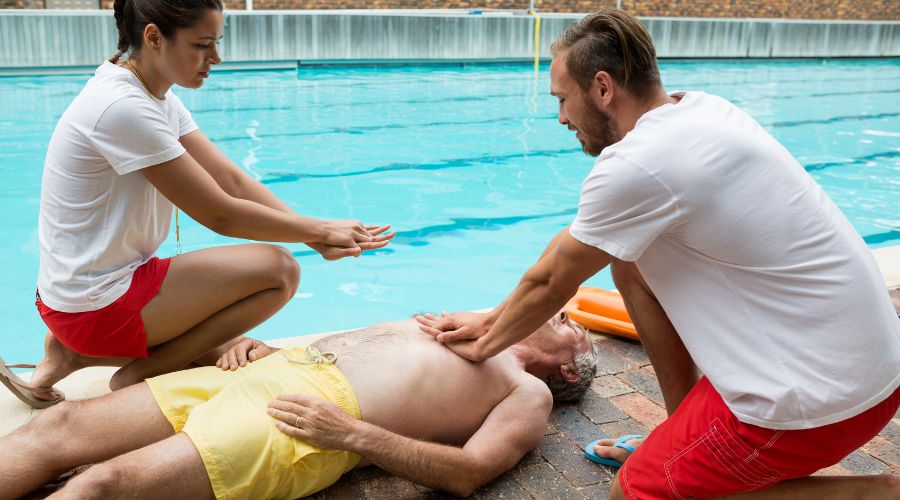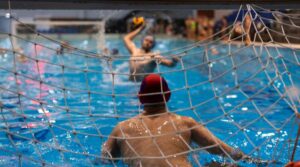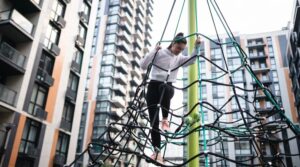When families and thrill-seekers visit a water park, they expect a day full of fun—not unexpected injuries. That’s why safety is at the core of every successful water attraction. Among the essential components of modern water park safety is an unsung hero: water park netting. This simple yet highly effective solution plays a vital role in preventing accidents, protecting guests, and ensuring a worry-free experience.
In this post, we’ll explore how water park netting helps reduce risks, its different applications, design and maintenance tips, and how your park can benefit from high-quality netting solutions.
Why Water Park Safety is Non-Negotiable
Water parks are inherently risky environments—wet surfaces, fast-moving rides, elevated structures, and large crowds all combine to create potential hazards. Ensuring the safety of every visitor isn’t just good business—it’s a legal and ethical responsibility. As water parks expand in scale and creativity, so does the complexity of accident prevention strategies.
From reducing liability to enhancing guest confidence, proactive safety infrastructure is key—and water park netting is one of the most effective yet overlooked solutions available today.
What Causes Accidents in Water Parks?
Understanding the risks is the first step to managing them. Here are some of the most common causes of water park accidents:
- Human error – such as running on slippery surfaces or ignoring safety rules
- Lack of supervision, especially with children in busy areas
- Mechanical or ride malfunctions
- Poor infrastructure design – including unprotected elevated areas or limited visibility
- Environmental hazards – such as falling debris or rain-slicked paths
Each of these hazards can be minimized with the proper planning and infrastructure, including well-placed netting systems.
What is Water Park Netting?
Water park netting refers to specialized mesh or fabric systems designed to prevent accidents and manage crowd movement throughout aquatic amusement parks. These nets are made from high-durability, weather-resistant materials capable of withstanding heavy moisture, UV exposure, and chlorine.
There are various types of netting used across different areas of a water park:
- Fall protection netting for elevated ride platforms
- Containment netting for lazy rivers and pools
- Debris netting to prevent leaves and objects from entering pools
- Themed or colored netting that blends safety with park aesthetics
At Nets Depot Inc., we specialize in custom-fit, high-strength netting solutions for water parks across North America. Our products are engineered to support both safety and visual appeal—giving guests a great experience while minimizing risk.
How Water Park Netting Prevents Accidents
Netting is one of the most versatile safety features you can install in a water park. Here’s how it actively prevents injuries and ensures safe guest interaction with rides and pool areas:
Fall Protection
Netting installed around slides, stairs, and high platforms acts as a critical barrier that can prevent guests from falling off or climbing into unsafe areas.
Zone Containment
Guests—especially children—can easily wander into dangerous or staff-only zones. Netting helps guide flow and separates safe areas from hazardous ones.
Overhead Debris Prevention
Outdoor parks often struggle with leaves, tree branches, or wildlife disturbing clean pool areas. Debris netting prevents foreign objects from landing in ride zones, ensuring hygiene and visibility.
Ride Exit Control
Netting helps control where and how riders exit high-speed slides and drop rides, reducing the chance of collision or improper dismount.
Effective Tips for Accident Prevention in Water Parks
To prevent accidents and ensure a safe experience for all guests, water parks must implement several key safety measures. Here are some effective tips for accident prevention:
- Staff Training: Ensure all staff members, especially lifeguards, are properly trained in first aid, CPR, and emergency evacuation procedures.
- Clear Signage: Use visible and informative signs to indicate rules, ride height restrictions, and hazardous areas to guests.
- Regular Inspections: Conduct regular safety checks on all rides, pool areas, and equipment to ensure they meet safety standards and are functioning properly.
- Slip-Resistant Surfaces: Install slip-resistant flooring in high-traffic areas like pool decks, stairs, and walkways to prevent slips and falls.
- Crowd Control: Manage the flow of guests by setting clear guidelines for capacity limits, maintaining proper supervision, and keeping guests within designated zones.
- Proper Ride Maintenance: Keep all water rides well-maintained and conduct routine inspections to identify any potential hazards before they can lead to accidents.
- Use of Safety Barriers and Netting: Install barriers and netting around elevated areas and water zones to prevent falls and keep guests within safe boundaries.
- Communication Systems: Ensure lifeguards and staff have effective communication tools (e.g., radios, alarms) to respond quickly to emergencies.
By following these proactive steps, water parks can significantly reduce the risk of accidents and provide a safer, more enjoyable experience for all visitors.
Designing and Installing Netting Correctly
It’s not just about adding a net—it’s about placing the right net, in the right place, with the right strength.
When designing your netting system:
- Always evaluate ride paths, heights, and foot traffic
- Choose materials rated for chlorine and UV resistance
- Test for strength and tear resistance
- Ensure all netting complies with ASTM and local building codes
To Maintain Water Park Netting, schedule routine inspections, especially in high-use areas. Look for signs of stretching, fraying, or anchor loosening. A good rule of thumb is to inspect nets monthly and replace every few seasons, depending on usage and environmental exposure.
Innovative Safety Features in Water Parks
As technology continues to advance, water park safety is evolving to include smarter, more responsive systems. Some parks are now incorporating smart netting equipped with sensors that alert staff if netting is compromised or if guests enter restricted areas. This tech integration not only improves real-time response but also enhances overall park security.
Other cutting-edge innovations include automated ride monitoring systems, integrated lifeguard technology, and drone-based surveillance for large-scale parks. As these technologies advance, water parks are becoming safer, more efficient, and better equipped to manage both emergency situations and daily operations.
How to Choose the Right Netting Provider
Not all netting is created equal. Choosing a reputable supplier is crucial.
Here’s what to look for:
- Custom-fit capabilities for unique park layouts
- ASTM-certified products for water-based attractions
- Chlorine and UV resistance for outdoor longevity
- Experience in water park environments
- Warranty and post-installation support
Check out our Google listing for reviews and examples of past installations. We’re proud to be a trusted name in the industry.
Planning for the Future: Smarter, Safer Water Parks
Water park design is evolving fast. Innovations like smart netting with sensors can now alert staff when netting is breached or compromised. Combined with video monitoring and motion sensors, netting becomes part of a smart safety ecosystem.
Additionally, eco-friendly netting made from recyclable materials is gaining traction, as parks seek sustainable solutions without compromising on strength or safety.
As technology and design intersect, expect netting to become more intelligent, less intrusive, and even more essential.
Why Water Park Netting is Worth the Investment
Safety investments aren’t just ethical—they’re smart business.
Benefits include:
- Fewer accidents and injury claims
- Improved guest confidence and satisfaction
- Easier insurance approvals
- Long-term cost savings on reactive repairs
- Better online reviews and return visits
Whether you’re designing a new park or upgrading an existing one, installing high-quality water park netting should be part of your safety master plan.
Contact Us – Get the Right Netting Solution
At Nets Depot Inc., we offer expert consultation, custom netting solutions, and full-service installation for water parks, aquatic centers, and amusement facilities.
👉 Ready to protect your park with proven solutions?
Call us today or visit our website to schedule a consultation. Our team will assess your site, recommend safety improvements, and help you choose the best netting system tailored to your needs.
Final Thoughts
As water attractions become more elaborate and crowded, safety netting offers a practical, low-profile way to reduce risk. It works around the clock—silently, reliably, and without impacting the guest experience. When integrated correctly, water park netting not only prevents accidents but reinforces your park’s reputation as a fun and safe destination for all ages.
Questions About Water Park Netting and Safety
Q1. What types of netting are used in water parks?
Water parks typically use several types of netting, each designed for specific functions:
- Fall protection netting is used on elevated platforms, rides, and walkways to prevent guests from falling.
- Containment netting is used around pools, lazy rivers, and wave areas to keep guests within safe boundaries.
- Debris netting prevents leaves, branches, and other environmental hazards from entering the water and causing accidents.
- Themed or decorative netting is also available for aesthetic purposes, blending safety with park design.
Q2. How does water park netting prevent accidents?
Water park netting plays a critical role in accident prevention by:
- Providing fall protection around elevated areas, like slides and observation platforms.
- Controlling crowd flow by restricting access to dangerous or restricted zones.
- Preventing debris from entering water zones, which can cause slips, trips, or drownings.
- Ensuring that guests remain safe and within designated areas, reducing the risk of collision or injury.
Q3. How often should water park netting be maintained?
To maintain water park netting, it’s essential to inspect the netting regularly, typically every month during peak seasons, to check for signs of wear or damage. Replacing damaged netting and ensuring that it’s properly tensioned will help prolong its life and maintain safety. Generally, water park netting should be replaced every 3-5 years, depending on the usage and environmental factors.
Q4. How do I choose the right netting provider for my water park?
When selecting a netting provider, consider the following:
- Customization options for your specific park layout and safety needs.
- Material quality—ensure the netting is UV-resistant, chlorine-resistant, and durable in wet conditions.
- Experience and certifications, especially in providing solutions for aquatic environments.
- Post-installation support and warranties to ensure the product will last and remain safe for guests.
At Nets Depot Inc., we specialize in providing high-quality, custom netting systems that meet the specific needs of water parks and aquatic facilities. Contact us for expert advice and tailored solutions.
Q5. Can water park netting help reduce insurance costs?
Yes! Installing water park netting can help reduce accident rates, leading to fewer injury claims and a lower overall risk profile. Many insurance providers offer discounts for water parks that implement proven safety measures, including netting systems. By enhancing safety with high-quality netting, you can potentially lower your premiums while improving guest safety and satisfaction.






